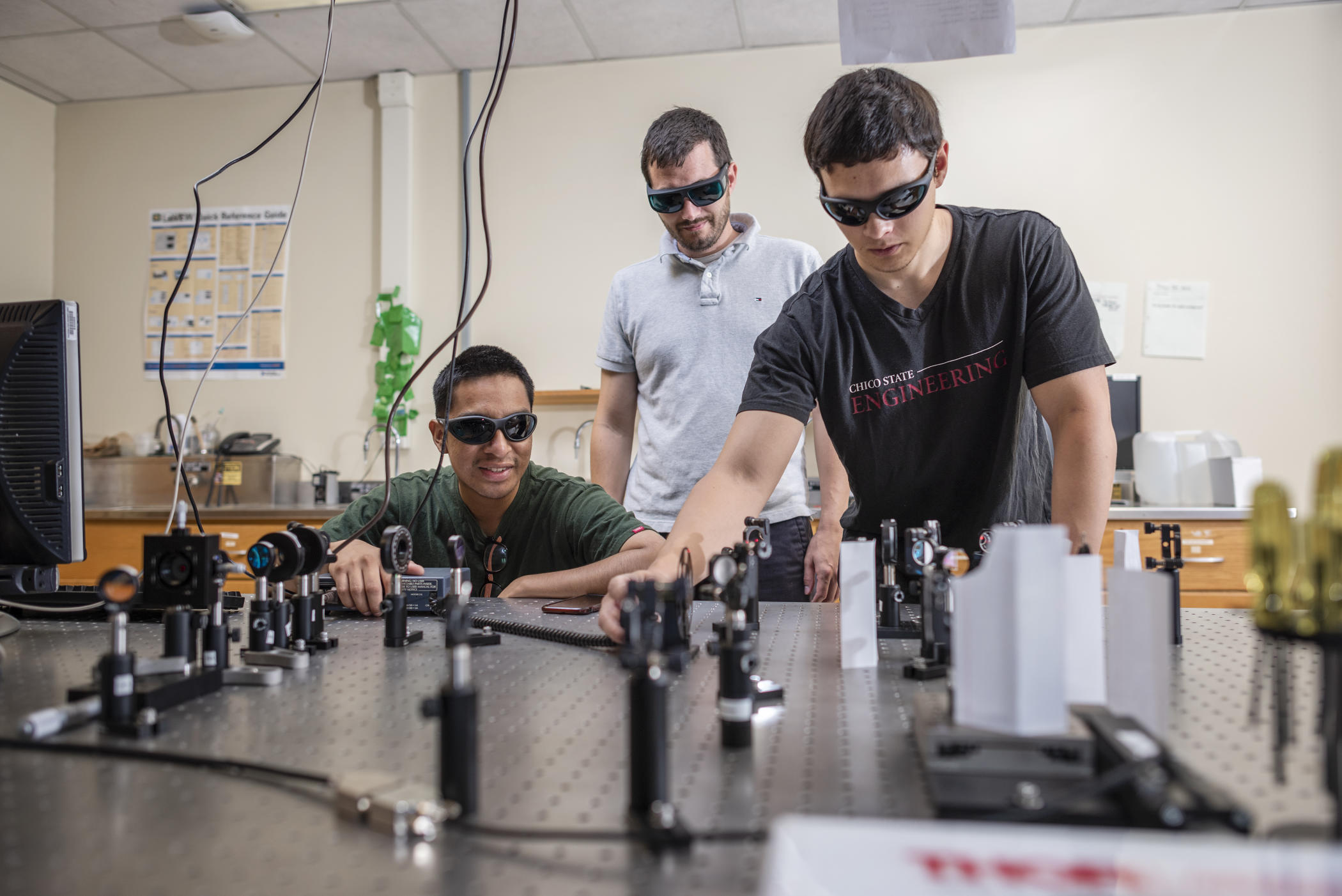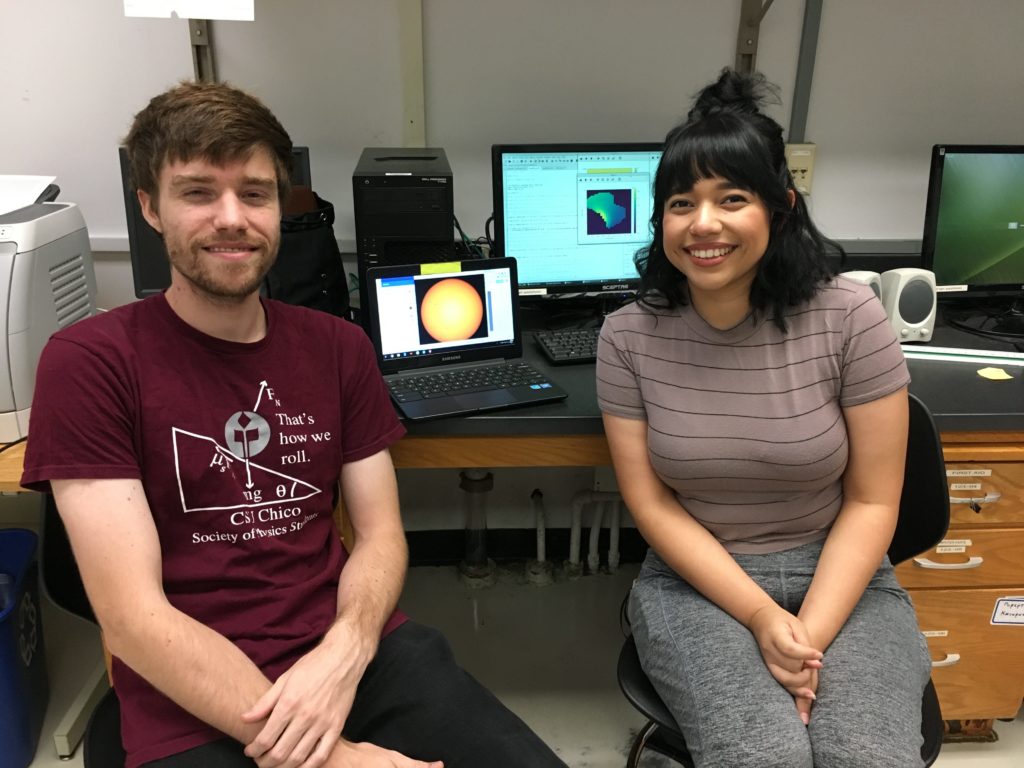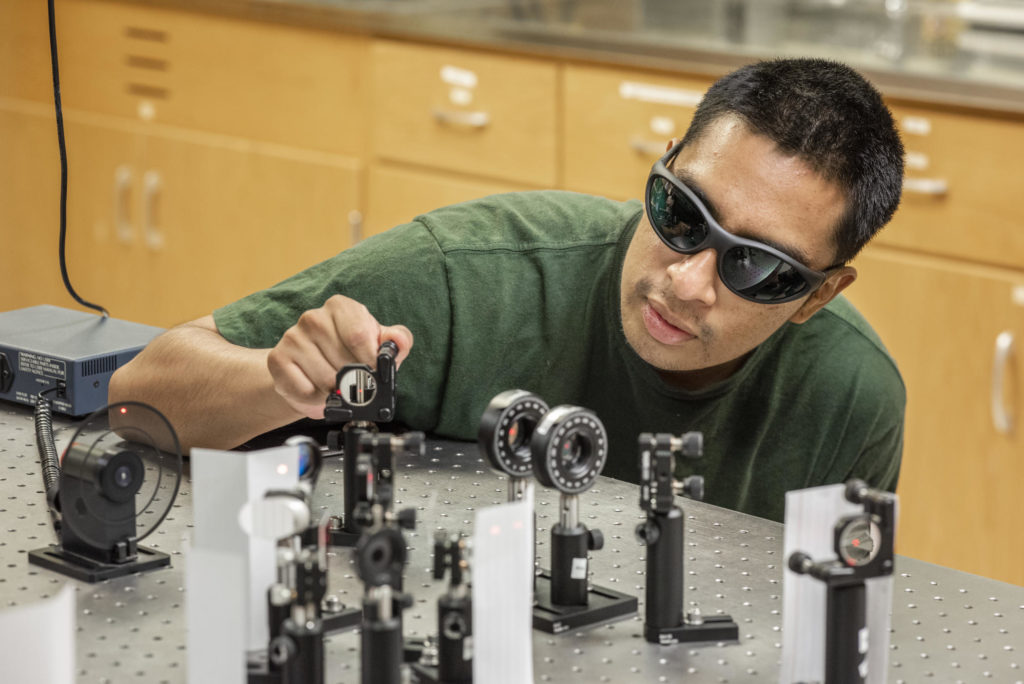Physics Research Institute Examines Space and Time

Faculty Paul Aripin (center) reviews Eddie Cruz (left) and John Schad (right) work on research about ultrafast spectroscopy to characterize molecular vibrations of laser dyes as part of the Chico STEM Connections Collaborative (CSC2) Natural Sciences Undergraduate Research Project (UGR) on Monday, July 16, 2018 in Chico, Calif. (Jason Halley/University Photographer/CSU Chico)
We continue to find planets, and we keep asking the same questions.
Have they sustained life? Could they ever? The answers are literally in the stars—and that’s where researchers are trying to look.
Under physics professor Nicholas Nelson’s mentorship, undergraduate researchers and physics majors Cynthia Perez and Forrest Bullard used highly detailed 3D supercomputer models of stars during the Physics Summer Research Institute (PSRI), a summer institute that pays students a stipend for their focused research. Perez and Bullard attempted to glean more insight toward the ultimate equation of habitability, one of six projects tackled by PSRI’s fifteen students. Their primary focus: solar behavior.
“We have found over 3,000 planets now, and with every one we find, the interest is in knowing if it could be habitable,” said Nelson, whose project received funding from a U.S. Department of Education Hispanic-Serving Institution Science, Technology, Education, and Mathematics (HSI STEM) grant. “Well, to be habitable, you probably want to have an atmosphere, and to answer that question, you need to know how the star works.”
By analyzing the behavior of these model stars’ magnetic fields and applying basic laws of physics, the group sought to study how those fields behaved and discover any correlation between a star’s planets, their atmospheres, and whether certain conditions might indicate the opportunity to sustain life.

Perez and Bullard did the bulk of their work analyzing massive amounts of data—getting a taste of life as a professional researcher.
“I’ve always wanted to be a scientist and have the experience of discovering things about the universe,” Bullard said. “And I wanted to find out if I can handle it over the six years of earning a PhD. Seeing if you can appreciate the work while you’re doing it is big.”
Using a 3-D model of a star, Perez entered ranges in latitude and longitude to create test areas, then analyzed that data over different periods of time to establish patterns.
“Ever since I was in first grade, and learned about the universe and planets, I remember thinking, ‘Wait, the earth ends? Where does it end?’” Perez said with a smile. “I didn’t know that physics would be so hard then! But ever since I was little I was interested in astronomy, and getting to do research about it now is really exciting.”
Perez’s role in the research project involved entering code to simulate convection under the sun’s surface, to understand how it may affect the sun’s magnetic fields.
“Convection is what we see when you boil water, and that’s what’s going on in the sun. There’s plasma that heats and rises, or cools and lowers,” Perez explained. “We’re trying to answer the questions of how that affects the magnetic fields.”
All of those variable queries—How strong is the magnetic field? Is it rising or falling? Does it rise at an angle?—are entered via code, and the results yield petabytes of data (one petabyte is a million gigabytes, or about the equivalent of 40 months of round-the-clock HD video recording). That data can only be processed by powerful supercomputers located at NASA or the National Science Foundation, which Chico State’s students access remotely. The data diving can be exhausting, but each new byte of information adds to the excitement.
Nelson said the model the campus is using is one we know best: Earth’s sun.
“If we can get it right for our solar system, where we have lots of data, that makes it easier to try out another star or different type of planetary system,” Nelson said. “But the hard part is knowing how the star behaves over billions of years, and we don’t have a good model for that. If we can build a model to say, ‘This is what this star was doing a billion years ago,’ or what a star like our sun will be doing in a billion years, then we can start predicting how things work or will work, as opposed to making a model that reproduces something we already know.”
To that end, Bullard’s research focused on the models themselves, and discerning how they develop over time—essentially, continually testing their predictive efficacy. He put a Chico State stamp on the widely-used simulation program this summer, becoming the first to mathematically verify that the star models in use are also chaotic, meaning they are prone to too many variables to be predictive beyond a certain amount of time, similar to weather patterns on Earth. As Chico State’s solar model research continues to undergo peer review, the hope is that understanding stars’ behavior over time will be achievable.
“If we find a planet where we can observe what a star was doing a billion years ago, and look at it now, we could determine how well its atmosphere behaved,” Nelson said. “We could know the difference and determine, ‘Well, this one over here ripped off its planet’s atmosphere, but maybe this one’s got a nice big atmosphere, and we should start selling spaceship tickets.’”
Real-time Molecular Dynamics with Ultrafast Spectroscopy
Professor Paul Arpin’s research group took its inspiration from the sun, too—though in this case, it was seeking to look at the mechanisms in photosynthesis and energy storage.

“We’re trying to understand those first few steps after light is absorbed and when it’s converted to stored energy. People are interested in an efficient energy storage model that’s not use-it-or-lose-it, like renting solar from PG&E,” Arpin said. “If we understand how nature does that so well, people can use it as a design principle. But those first of many, many reactions in photosynthesis happen in really fast time scales—only a few hundred femtoseconds.”
One femtosecond is to a second as one second is to 32 million years. “Really fast,” indeed.
“To resolve things that fast,” Arpin said, “we use lasers.”
Funded by the HSI STEM grant, PSRI Cheuk-Kin Chau Summer Research Award, and support from the College of Natural Sciences, the institute had a two-student team build an experiment using ultra-fast laser pulses to catch chemical reactions in progress. The instrument, built by students John Schad and Eddie Cruz under Arpin’s instruction, is designed to initiate and analyze those reactions.
One laser pulse hits the molecule, as sunlight hits a leaf, and then another laser pulse is triggered to monitor the dynamics of the reaction. The understanding and design of the tool itself took up the bulk of the summer research, in fact—the institute ended on August 10, before data collection could begin. The focus for physics major Cruz and Schad, a physics and electrical and electronic engineering double major, was mostly in creating an automated, integrated system to synchronize timing between computers and equipment.
“This kind of experience is really valuable. It’s what research is, to me,” said Arpin, who estimated that in his six years of doctorate study, he spent only three days collecting data. “A lot of experimental science is about learning the tools you need to be able to ask your questions. It’s vital.”


